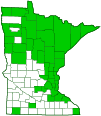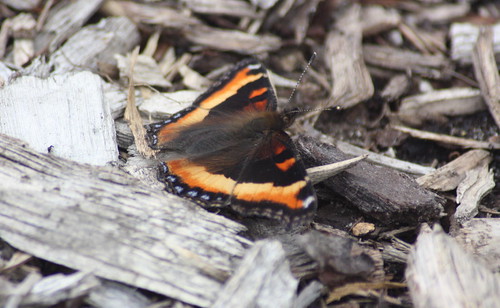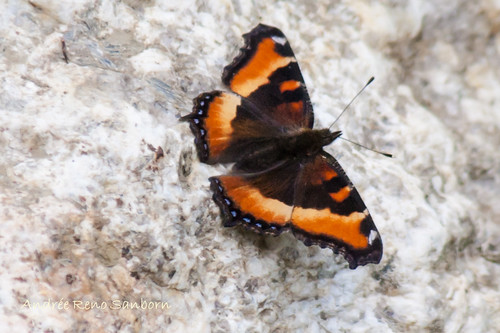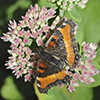Milbert’s tortoiseshell
(Aglais milberti)
Conservation • Description • Habitat • Ecology • Distribution • Taxonomy
Conservation Status |
|
|||||||
| IUCN Red List | not listed |
|||||||
| NatureServe | N5 - Secure S5 - Secure |
|||||||
| Minnesota | not listed |
|||||||
Description |
||
Milbert’s tortoiseshell is a medium-sized brush-footed butterfly. It has a wingspan of 1⅝″ to 2½″. Males and females look alike. The upperside of both wings is dark brown from the base to the postmedian band; has a broad, bright orange submarginal band that grades to yellow toward the inner edge; and a narrow black marginal band. The tip of the forewing is squared off. The forewing has two orange patches on the leading edge of the basal area, and a dark brown patch and white spot on the leading edge of the subapical band. The marginal band of the forewing has row of pale crescent-shaped to irregular spots. Some of the marginal spots on the hind wing may be light blue. Overwintering individuals emerging from hibernation are paler and appear tattered. The underside of both wings is dark brown with a broad, lighter brown submarginal band The caterpillar is black above, pale below, and up to 1⅜″ long. The spiracles are black with a broad white border. There is a row of pale, yellowish crescents below the spiracles that may be joined to form a lateral stripe. The thorax and abdomen are covered with numerous, pale, straight, hair-like structures (seta). The broad base of the seti are pale, making the body look speckled. On the thorax and each abdominal segment there is a long, thick, stiff spine (scolus) in the middorsal, subdorsal, and supraspiracular regions. The scoli are not obviously branched. The head is black and is covered with a mix of both black and white hairs but no scoli. The anterior leg-like structures (prolegs) are pale. The thoracic legs and the anal proleg are black. Mature caterpillars are found in spring and again in early summer. |
||
Size |
||
Wingspan: 1⅝″ to 2½″ |
||
Similar Species |
||
| No similar species | ||
Habitat |
||
Woodland openings; moist fields, meadows, and pastures near woodlands; streamsides; trails; and roadside ditches. |
||
Ecology |
||
Season |
||
Two broods: Mid-June to mid-August; and early September to late October and April to early May (hibernating) |
||
Behavior |
||
The male will perch to watch for passing females. |
||
Life Cycle |
||
The female lays bunches of usually 50 to 150 but up to 900 green, cone-shaped eggs on the undersides of stinging nettle leaves. When the eggs hatch the first instar caterpillars form a silky communal web in which they feed. Mature instars are solitary. They create individual silky nests on a folded leaf and feed alone. There are two broods each year. Adults of the second brood hibernate, sometimes in groups, in bark crevices or on human structures. |
||
Larva Hosts |
||
In Minnesota, only American stinging nettle |
||
Adult Food |
||
Mostly flower nectar, but also sometimes sap, rotting fruit, and dung. |
||
Distribution |
||||
|
Sources |
|||
| 9/5/2022 | ||||
Occurrence |
||||
Fairly common |
||||
Taxonomy |
|||
Order |
Lepidoptera (Butterflies and Moths) | ||
Superfamily |
Papilionoidea (Butterflies) | ||
Family |
Nymphalidae (Brush-footed Butterflies) | ||
Subfamily |
Nymphalinae (Checkerspots, Anglewings, Peacocks, and Allies) | ||
Tribe |
Nymphalini (Ladies, Anglewings, and Allies) | ||
Genus |
Aglais (Tortoiseshells) | ||
Subordinate Taxa |
|||
Milbert’s tortoiseshell (Aglais milberti milberti) Milbert’s tortoiseshell (Aglais milberti pullum) Milbert’s tortoiseshell (Aglais milberti subpallida) Milbert’s tortoiseshell (Aglais milberti viola) |
|||
Synonyms |
|||
Nymphalis milberti |
|||
Common Names |
|||
Milbert’s tortoiseshell |
|||
Glossary
Instar
The developmental stage of arthropods between each molt; in insects, the developmental stage of the larvae or nymph.
Proleg
A fleshy structure on the abdomen of some insect larvae that functions as a leg, but lacks the five segments of a true insect leg.
Scolus
Plural: scoli. A spiny, branched projection from a larval body wall, the branches terminating with a single stiff, hair-like or bristle-like tip.
Seta
A usually rigid bristle- or hair-like structure on butterflies and moths used to sense touch. Plural: setae.
Spiracle
A small opening on the surface of an insect or arachnid through which it breathes.
Visitor Photos |
|||||
Share your photo of this insect. |
|||||
| This button not working for you? Simply email us at info@MinnesotaSeasons.com. Attach one or more photos and, if you like, a caption. |
|||||
Dan W. Andree |
|||||
Milbert's Tortoiseshell... At Frenchman’s Bluff SNA. I had no idea what it was. At first from a distance thought it might be a darker colored Variegated Fritillary but got closer to it and seen it was a butterfly I had never seen before. Its colors reminded or made me think of fall harvest decorations. Like fall color leafs and orange and brown etc. colors pumpkin colors etc. Beautiful butterfly. Also for a first time seen some Common Copper Butterflies at Twin Valley Prairie SNA. I filmed and photographed them they were little and really cute. I got some photos of that Tortoiseshell so will see how they turned out I filmed it but not sure if I got it very good. I haven’t uploaded the footage to a larger monitor. I know the Common Copper photos and video is really nice so hope some of the Milbert’s Tortoiseshell is nice to. I do think some photos will be but not so sure about the video. Seen so many Monarch’s at both SNA’s mentioned here. I swear a couple hundred or more. They were feeding on mostly prairie blazing star flowers. I could carefully walk through areas and monarchs flew up 3-6 feet in front of me. Some just sat and fed if I was motionless. Not a very spooky butterfly. A few were still mating but most feeding. Must have been a hatch out or something. Didn’t see any regals and haven’t seen any at all at Frenchman’s this whole season but did see a few males at the other mentioned SNA which was nice to see. |
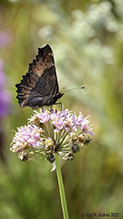 |
||||
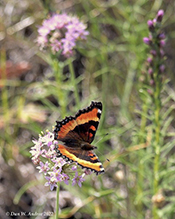 |
|||||
Monarchs seem to be doing extremely well in the two mention SNA’s which is good but some other lesser known species not so much. Monarchs were the only species of large butterflies seen. Only seen 2 painted ladies which sometimes they can be all over the place but not a whole lot of species observed this season other than the Monarchs and happy to say lots of them. Concerning though for the other species. … Seen the Tortoiseshell and Common Coppers yesterday mid afternoon to late afternoon. Seems to be on a wild prairie onion blooming. |
|||||
Nicole Vasquez |
|||||
Mixed in with Painted Ladies on flowering Sedum |
|||||
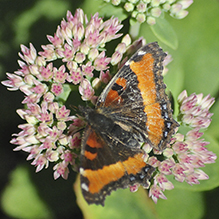 |
|||||
Bill Reynolds |
|||||
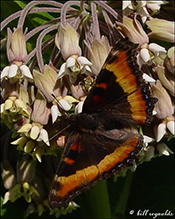 |
|||||
MinnesotaSeasons.com Photos |
|||||
|
|||||


Visitor Videos |
|||
Share your video of this insect. |
|||
| This button not working for you? Simply email us at info@MinnesotaSeasons.com. Attach a video, a YouTube link, or a cloud storage link. |
|||
Other Videos |
|||
| Milbert's Tortoiseshell - Cypress Hills, Alberta wetvideocamera |
|||
About
Uploaded on Apr 16, 2011 Milbert's Tortoiseshell Butterfly seen near Elkwater, Alberta in the Cypress Hills. ( Aglais milberti ) May 2004 |
|||
| Milbert's Tortoiseshell Caterpillars on Stinging Nettle Todd Stout |
|||
About
Uploaded on Aug 12, 2011 (Please forgive the lousy audio.) Differentiating Milbert's Tortoiseshell larval nests vs. Red Admirals larval nests on stinging nettle is not too difficult because of the incredible levels of feeding damage that Milbert's Tortoiseshell caterpillars cause. This occurs because female Nymphalis milberti lay their eggs in clutches of over 100 eggs. By the time these larvae grow to maturity, their incredible feeding damage is obvious on the host plant. |
|||
| Milbert's Tortoiseshell Butterfly emerges in time lapse JCMegabyte |
|||
About
Uploaded on Jan 30, 2007 This Milbert's Tortoiseshell (Nymphalis milberti) emerges in this time lapse sequence. Actual time is about 2-3 minutes. Much more butterfly/moth video, photography and life cycle studies available free to the public at HTTP://jcmdi.com |
|||
| フルHDでムビる00785 ヤンキーコヒオドシ♂ alwaysartzone |
|||
About
Published on Jul 23, 2012 フルHDでムビる00785 ヤンキーコヒオドシ♂ Aglais milberti male 2012-07-12:in Canada (Emerald Lake) |
|||
| Finding satyr comma and milbert's tortoiseshell caterpillars on stinging nettle indroid2 |
|||
About
Uploaded on Jul 2, 2009 This video reviews the different nests and larval preferences of the milbert's tortoiseshell (Nymphalis milberti) and the satyr comma (Polygonia satyrus neomarsyas) on stinging nettle (Urtica dioica.) Warning! Handling stinging nettle with your bare hands can be painful. Handle with gloves! |
|||


Last Updated:
